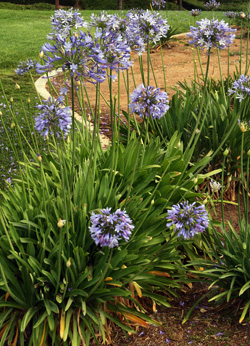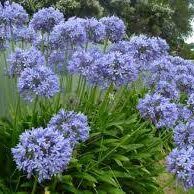Spectacular Agapanthus: Enhancing Your Yard's Beauty
Spectacular Agapanthus: Enhancing Your Yard's Beauty
Blog Article
Letting Loose the Secret to Effective Agapanthus Growing: Idea for a Flourishing Yard
In the world of horticulture, cultivating agapanthus effectively needs a calculated technique that encompasses various elements of plant care. With mindful focus to information, one can unlock the secrets to nurturing these stunning flowers, bring about a garden that grows with elegance and vibrancy. By understanding the subtleties of agapanthus cultivation, one can produce an environment where these plants prosper and grow abundantly. In the following discussion, we will check out essential ideas and techniques that will certainly direct you towards a growing agapanthus yard, providing insights right into best techniques, soil problems, sprinkling methods, and a lot more.
Growing Agapanthus: Ideal Practices
When planting Agapanthus, proper dirt prep work is important for guaranteeing successful development and advancement of these attractive flowers. Agapanthus, commonly referred to as Lily of the Nile or African lily, flourishes in well-draining dirt with a somewhat acidic to neutral pH level - Agapanthus. Prior to planting, it is critical to change heavy clay soils with raw material such as compost or peat moss to boost drainage and offer essential nutrients for the plants
To plant Agapanthus, choose a location that obtains full sunshine to partial shade, as this will certainly advertise healthy development and plentiful blooming. Dig a hole twice the diameter of the plant's origin round and put the Agapanthus at the same depth it was formerly growing. Delicately backfill the opening with soil, weighing down strongly to eliminate any air pockets around the origins.
Water the recently grown Agapanthus completely and remain to keep the soil equally damp, especially during the plant's active expanding period. Agapanthus. Using a balanced fertilizer once a month can further support the plant's growth and blooming. By complying with these finest techniques for growing Agapanthus, you can develop a stunning display of these fascinating flowers in your yard
Suitable Soil Issues for Agapanthus
For optimal growth and growing success of Agapanthus plants, making sure the soil conditions are perfect is critical. Agapanthus chooses dirt that is rich in nutrients, so including a balanced plant food throughout the growing period can promote healthy development and vibrant blossoms.

Watering and Feeding Tips
To make certain healthy and balanced development and vibrant flowers, appropriate watering and feeding techniques are essential for successful Agapanthus cultivation. Agapanthus plants profit from normal watering, specifically during the growing season. It is recommended to water deeply once a week, ensuring the soil is moist but not waterlogged. Throughout warm climate or in pots, even more constant watering might be needed to stop the dirt from drying out completely.
When it involves feeding Agapanthus, a well balanced plant food with equivalent parts nitrogen, phosphorus, and potassium can be used in the springtime to promote healthy development and blooming. Slow-release fertilizers are perfect for providing nutrients gradually over an extensive period. Avoid over-fertilizing, as this can lead to too much foliage development at the expenditure of flowers.
Additionally, including raw material like garden compost right into the soil can boost nutrient levels and improve dirt structure, assisting in the general health of the Agapanthus plants. By adhering to these watering and fertilizing tips, garden enthusiasts can ensure their Agapanthus plants grow and produce magnificent displays of blossoms.
Trimming and Deadheading Techniques
Appropriate trimming and deadheading methods play an important role in keeping the health and wellness and visual appeals of Agapanthus plants, enhancing the vital practices of watering and feeding for successful growing. Trimming Agapanthus includes getting rid of website here spent blossom heads, yellowing or dead fallen leaves, and overall shaping of the plant to promote far better development. Deadheading, the process of eliminating discolored blossoms, not just enhances the plant's appearance however also motivates more blooming.
When deadheading Agapanthus, it is a good idea to snip off the flower stem at the base making use of sharp, clean shears. This process reroutes the plant's energy from seed production back right into origin and foliage growth, promoting a much healthier and extra durable plant. Regular deadheading can prolong the growing duration of Agapanthus and protect against self-seeding, which a fantastic read can lead to overcrowding.
In regards to trimming, Agapanthus typically gain from a light trim after flowering to clean the plant and motivate fresh growth. Cutting down the spent flower stems and removing any dead or damaged vegetation aids keep the plant's vitality and general look. Nonetheless, it is vital to stay clear of reducing into the crown of the plant, as this can deteriorate its health and wellness.

Protecting Agapanthus From Vermins and Diseases
Applying reliable insect and disease monitoring approaches is vital to protecting the health and vigor of Agapanthus plants in growing. One common pest that influences Agapanthus is visit the website the Agapanthus borer, a caterpillar that tunnels into the plant, creating damage to the flowers and leaves.
In enhancement to insects, Agapanthus are vulnerable to illness such as root rot and fungal leaf spots. By staying watchful and dealing with insect and disease problems without delay, gardeners can help their Agapanthus flourish and flourish.

Verdict
To conclude, successful cultivation of agapanthus requires appropriate planting strategies, optimal soil problems, adequate watering and feeding, normal trimming and deadheading, and defense from conditions and pests. By complying with these suggestions and tricks, gardeners can ensure a flourishing yard loaded with attractive agapanthus blossoms. Agapanthus. Bear in mind to preserve constant treatment and focus to information to advertise the health and wellness and longevity of these stunning plants
When planting Agapanthus, correct dirt preparation is important for guaranteeing successful development and advancement of these stunning flowers.Water the freshly grown Agapanthus completely and continue to maintain the dirt evenly moist, specifically during the plant's active expanding season.For optimal development and flowering success of Agapanthus plants, guaranteeing the dirt problems are optimal is essential. When transplanting or growing Agapanthus, make sure the soil is well-prepared to offer the needed structure for the plants to establish themselves successfully. One common insect that influences Agapanthus is the Agapanthus borer, a caterpillar that tunnels right into the plant, creating damages to the leaves and flowers.
Report this page